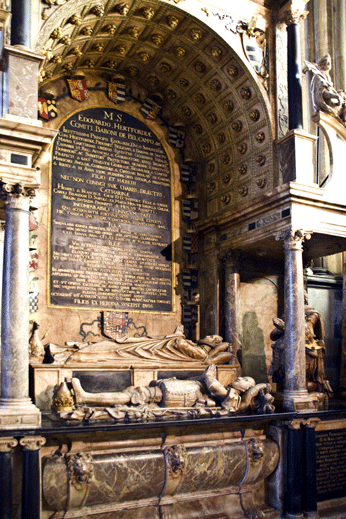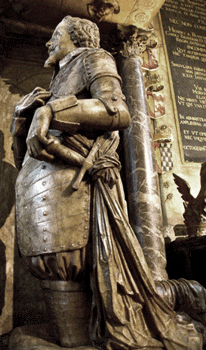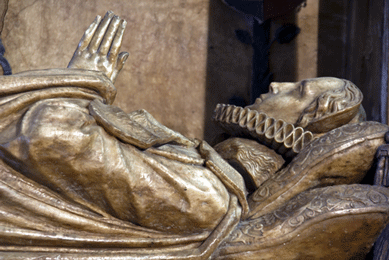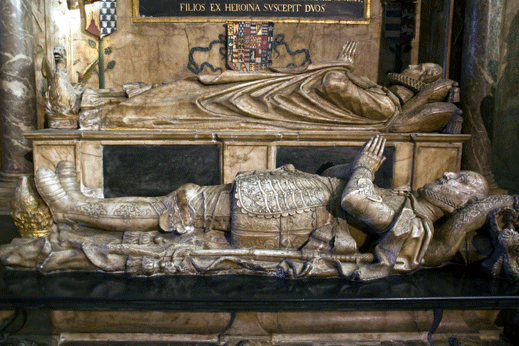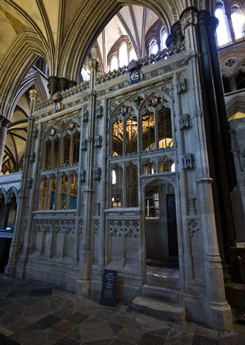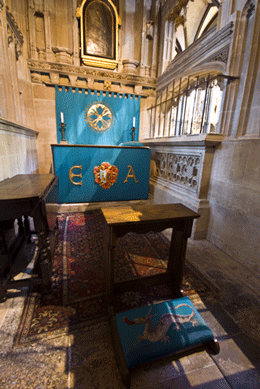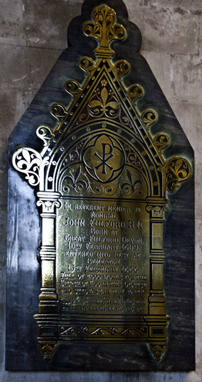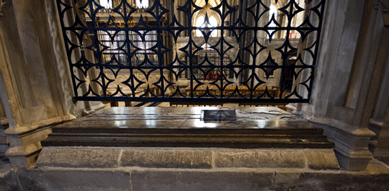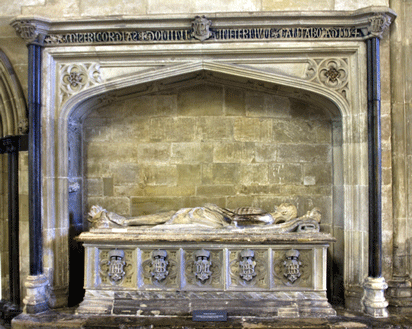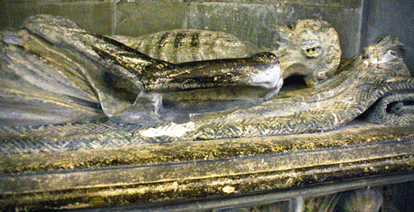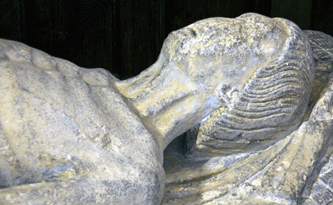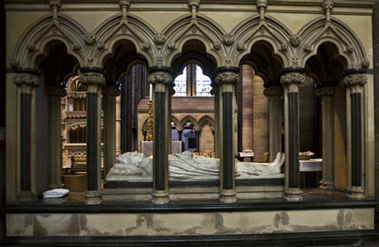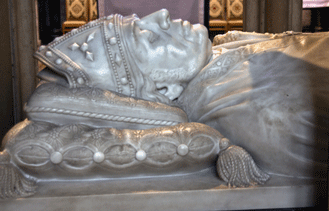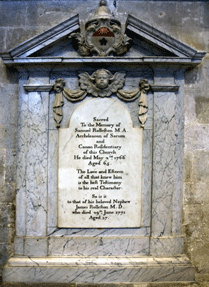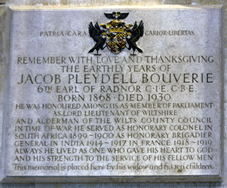 |
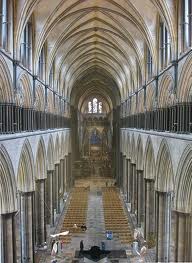 |
Salisbury Cathedral |
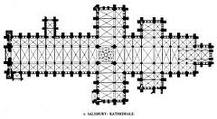 |
| Salisbury Cathedral is a Cathedral of the Old Foundation. The see was founded at Sherborne in 703, moved to Ramsbury in 920, to Sherborne again in 1058, to Old Sarum in 1075, and finally Salisbury in 1228. Park in a city pay car park. There is no compulsory entrance fee but a donation of around £6 or £7 is respectfully requested. I understand photography is allowed |
|
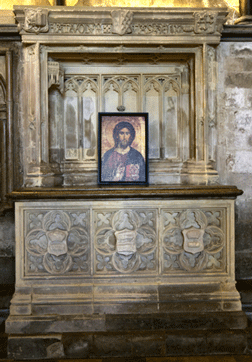 William Wilton (1523) Chancellor of the Cathedral. Stone tomb chest with Purbeck Marble lid. Heraldry S Wall |
| Trinity Chapel |
 Above: Coffin Lid of black Tournai Marble of 11th or 12 C. Brought from Old Sarum. Said to be that of St Osmund (1099) This date appears on this lid but this was added in 16th or 17th century. S Wall Left: Bishop John Wordsworth (1911) White marble effigy on black marble tomb chest. Signed: George Frampton (1914) N Wall |
|
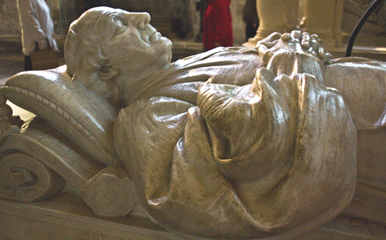 |
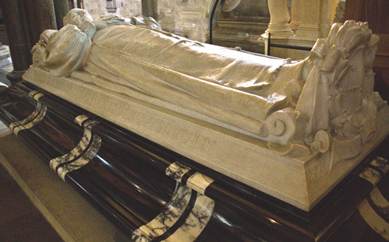 |
|
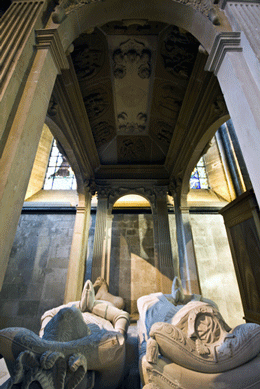 Sir Thomas Gorges (1610) and Helena (Schnachenberg, Dowager Marchioness of Northampton) . Bath Stone. Erected in 1635 E.Wall |
Chapel of St Peter & the Apostles |
 |
|
 |
|||
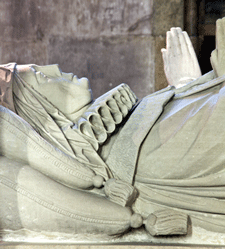 |
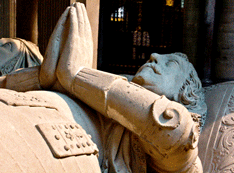 |
||
| The Ambulatory |
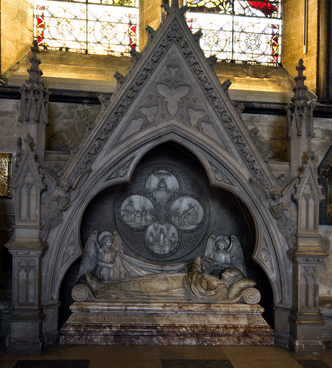 |

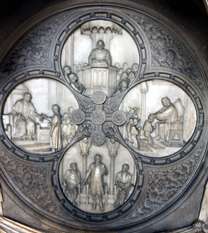
|
|
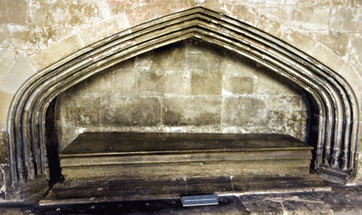 |
|||
|
Above: Tomb recess with slab 15th century
Purbeck marble coffin lid with cross, 13th century set in the above and possibly that of Bishop Roger N Wall Right: Bishop George Moberly (1885) Canopied recess in which coffin lid and effigy. Designed by Sir Arthur Blomfield; executed by Thomas Nicholls S Wall
|
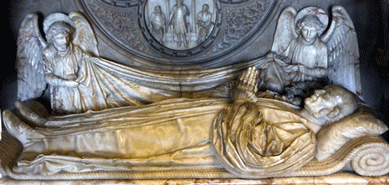 |
|
Choir -
North Aisle (Progressing from the east - so the easternmost is the first bay - to the west; the 'fourth bay' is more properly the north east transept) |
| First Bay |
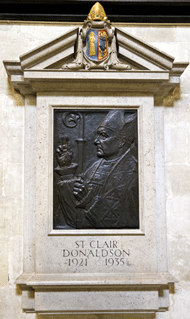 |
|
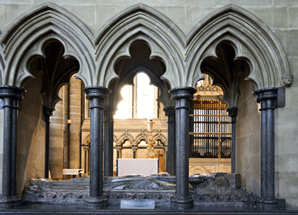 |
 |
|
| Above
Left & Centre:
Purbeck marble coffin lid with effigy of bishop (early 13th
century); now in 19th century aedicule designed by Scot,
the original being destroyed by Wyatt in 1789. Traditionally said
to be cenotaph of Bishop Richard Poore, who
founded the present cathedral but more likely
Bishop Robert de Bingham (1246) , who was responsible
for the completion of the choir. Far right: Bishop St Clair Donaldson (1936) Relief portrait in bronze by A G Wyton (signed) |
||
|
|
||||||||||||||||||
|
|
|
|
||
| Douglas MacLean
(1925) White marble tablet with alabaster frame Thomas Kingsbury (1899) White marble tablet with gray surround |
Below: Dean Gilbert Kymer (1463) (also said to be that of Bishop Woodville, 1484) Purbeck marble tomb chest with canopy. Top has indent for a brass. |
||
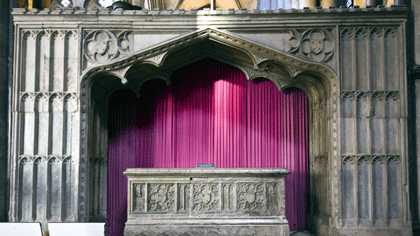 |
|||
|
Choir -
South Aisle (Progressing from east to west; the 'fourth bay' is more properly the south east transept) |
|
|
||||||||||||||
| Third Bay | ||||
 |

Left & Above: Bishop Giles
de Bridport (1262) The aedicule is of stone and Purbeck
marble. Inside is the Purbeck coffin surmounted by its lid carved
with the figure of the bishop.
Right: Mary Barnston (1625) Purbeck tablet in stone painted with shields; Also her husband Canon Barnston (1645) |
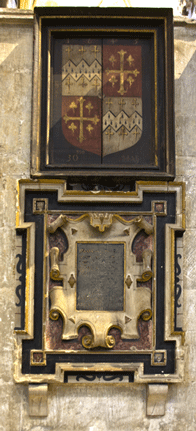 |
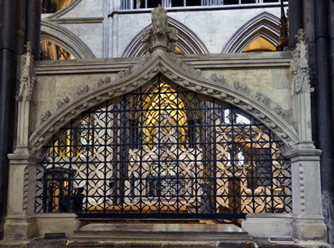
Bishop Simon de Gandavo (1315)
Purbeck marble tomb
slab with brass indent. Above is a canopy and grille, early
14th century
|
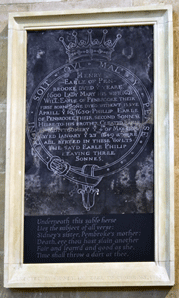
Above:
Herbert Family,
Earls of Pembroke (1600-1732)
Slate tablet erected 1963
|
| Fourth Bay | Fifth Bay | Sixth Bay | ||
| There are no monuments in this bay |
 |

Left:
Bishop John Davenant (1641)
Marble, attributed to
Joshua Marshall
Above: Bishop John Capon or Salcote (1557) stone tomb chest, paneled with quatrefoils enclosing shields Right: Dean George David Boyle (1901) coloured marble tablet |
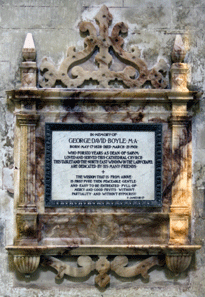 |
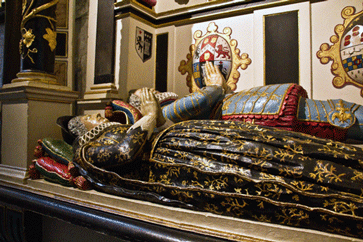
Sir Richard Mompesson (1627) &
Katherine (Pagington) Painted stone, repainted in
1964. Probably by the master of the Hertford monument (see
above).
|
| Seventh Bay |
 |

Bishop Richard Medford (1407)
Secretary to Richard II. Alabaster tomb chest with
Purbeck marble top and alabaster effigy; Chilmark stone canopy.
Much painting and gilding remain
|
|
|
|
North Transept This transept has three chapels to the east |
|
West Wall (progressing along the west wall from south to north, then along the north wall from west to east) |
||
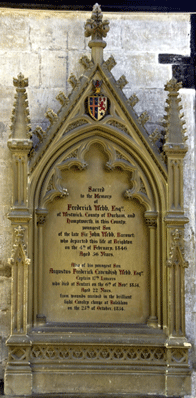
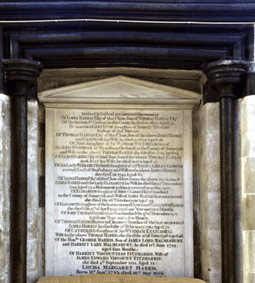
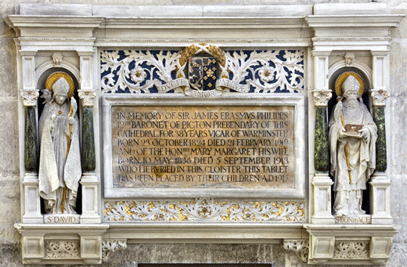
Above from Left to Right: 1)
Frederick Webb
(1846) and his son
Augustus Frederick
Cavendish Webb (1845 - dow Balaclava) By
Osmond. 2) Harris
Family from
James (1679)
to
Louisa Margaret (1826)
White marble
tablet. 3)
Sir James Erasmus Philipps ( 1912) & Mary Margaret
(1913) Classical tablet, flanked by two niches with
figures of St David & St Boniface. 4) James Harris (1780)
Tablet with bas relief of
seated female with medallion portrait. By
John Bacon.
5) George Lawrence (1861)
Tablet with
kneeling female figure leaning on urn. By
T Gaffin.
|
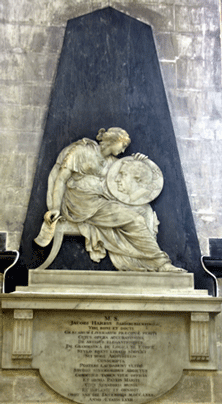 |
 |

Above & Right: James Harris, First Earl of Malmesbury (1820)
Plinth with life size reclining male figure reading a
book. By Francis Chantrey 1823
|
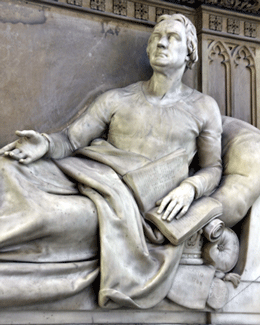 |
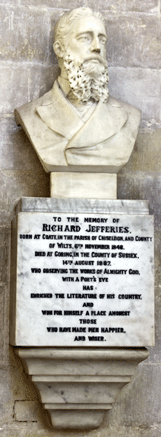 |

Above & Left: Richard Jeffries (1887) Bust on plinth. By
Margaret Thomas 1892
|

Above & Right:
William Benson Earl (1796)
Tablet with
figure of a Muse unveiling a Good Samaritan. By
John Flaxman
|
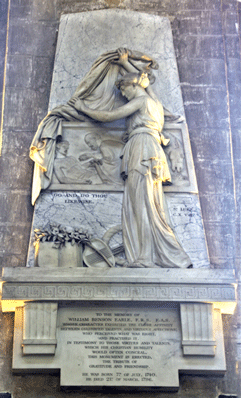 |
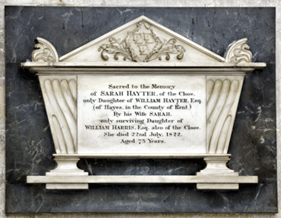
Above:
Sarah Hayter (1822)
Tablet shaped like
sarcophagus by Osmond
Left: General George Mitchell (1846)Oval medallion by Osmond Next Left: John Britton (1857) the Antiquarian. Brass by John Hardman & Co Far Left: Revd Edmund Benson (1835) & Ann (1826) Large tablet in Tudor style by Osmond |
 |
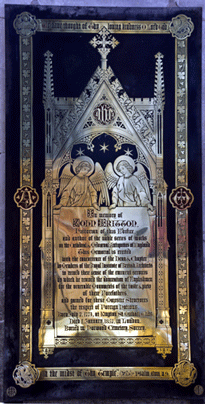 |
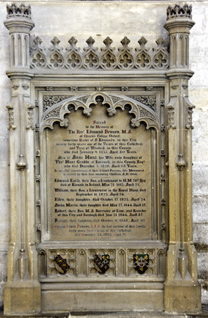 |
| North Wall | ||||
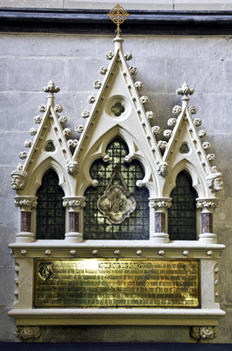 |
 |
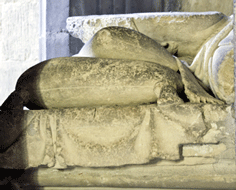
Far Left: Sergeant Major John Michael Peniston
(1858) Gothick canopy with tiled niches by
Osmond:
inscribed brass by
Waller
Left & Above: Bishop John Blythe |
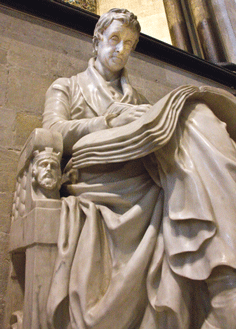
Above & Right:
Sir
Richard Colt Hoare Bt (1818)
Historian of Wiltshire. Marble by
R C Lucas
1841 |
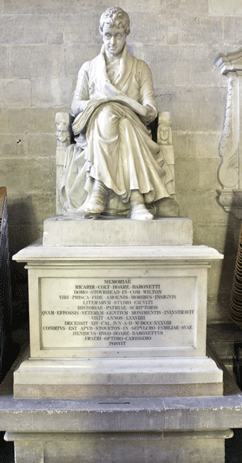 |
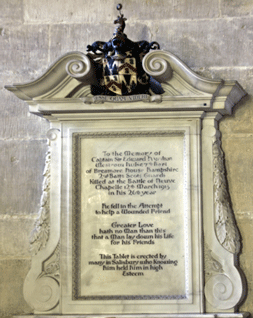 |
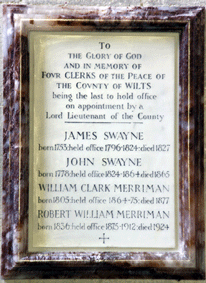 |
| Capt. Sir Edward Hamilton Westrom Hulse (1915) White marble tablet. | James Swayne (1827), Robert Swayn(1865), William Clark Merriman (1877) & Robert William Merriman (1924) All clerks of the peace. Tablet |
| Chapel of St Edmund of
Abingdon This is the central of the three chapels |
Chapel of St Thomas |
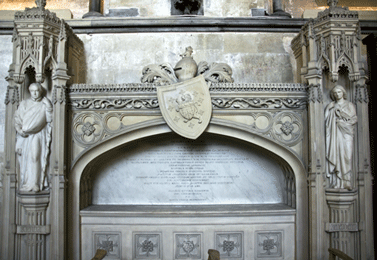 |
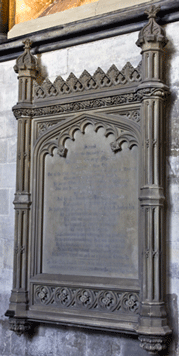
 |
| Above: William Long (1818) The figures are of marble and represent Learning and Charity. By John Flaxman Between St Edmund & St Thomas chapels |
Above left:
W G Maton (1835) Stone
tablet in Tudor style by Osmond
E
Wall Above right: George Jackson Christian & Wife (1857) Both killed in the Mutiny of the Sepoys . Also but not shown: Walter Long (1807) Surgeon. Marble tablet with flanking figures and portrait medallion. Signed by John Flaxman N Wall |
| Chapel of St John the Baptist | |
| Other Monuments | |
|
Lettice Cotton (1798)
Black,
white & gray tablet
E Wall Rev Edward Moore (1812) & Mary (1822) White tablet E Wall Sarah Evans (1804) & James Evans (1825) White tablet E Wall |
Louisa Brodie (1816)
E Wall Anna Maria Sturges (1803) tablet with urn E Wall Anne Seyner (?) tablet with urn E Wall White marble tablet (obscured by organ) E Wall |
|
South Transept This transept has three chapels to the east (progressing along the west wall from north to south ) |
| West Wall |
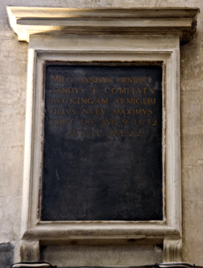 |
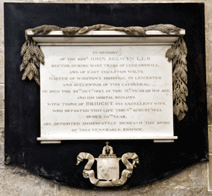 |
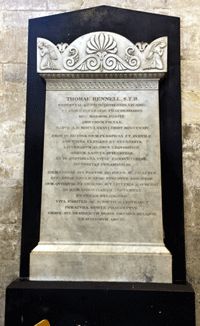 |
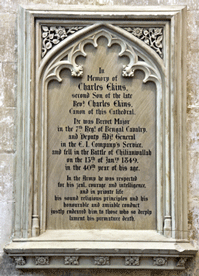 |
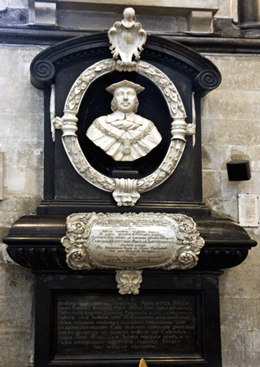 |
 |
| Milo Sandys (1632) Slate tablet in stone frame |
Above:
Revd John Selwyn (1823)
Master of Wigston's
Hospital, Leicester. White marble tablet on black slab Right: Thomas Rennell (1824) Attributed to Flaxman |
Charles Ekins (1849) Bengal Cavalry. By Osmond | Sir Robert Hyde (1665) Recorder of Salisbury and Chief Justice of Common Please. Possibly by Joshua Marshal or Besnier (B Bailey) | ||
 |
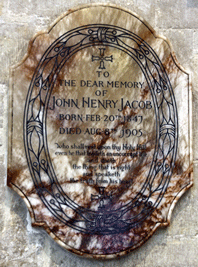 |
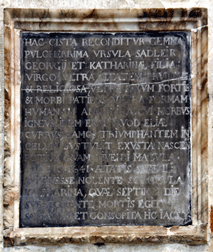 |
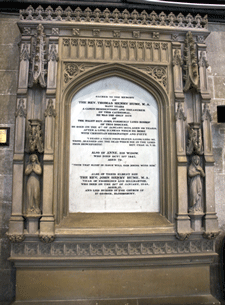 |
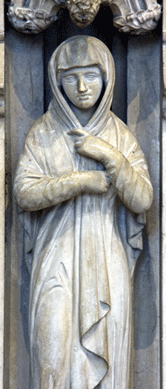 |
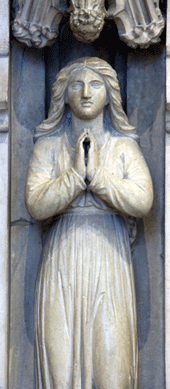 |
 |
| Bishop John Thomas (1766) Marble tablet | John Henry Jacob (1905) Alabaster tablet | Ursula & Katherine Sadlier (1641) Black marble tablet with marble frame | Above & right: Thomas Henry Hume (1834) treasurer. Marble tablet in Gothick stone surround by Hopper of London | Charles Langford (1635) painted tablet |
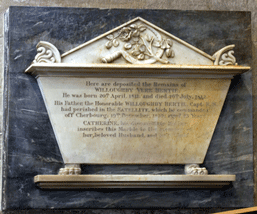 |
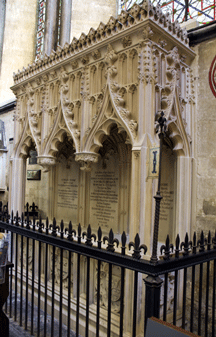 |
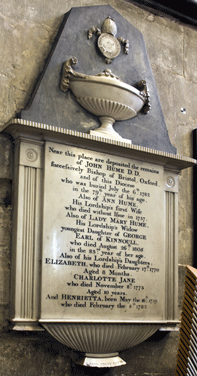 |
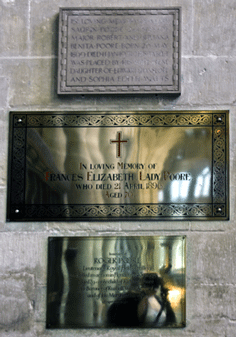 |
Other Monuments in the South Transept, West Wall |
|
Robert Hay (17th C)
Purbeck marble tablet in marble surround General A L Layard (1823) White marble tablet on slate base Lt-Col Roger Alvin Poore (1917) kia Passchendaele. Marble tablet on slate base |
||||
| Willoughby Vere Bertie (1812 at 1 year) and his father Willoughby Bertie (1810 lost at sea) White marble sarcophagus on black tablet by Osmond | Edward Poore (1780) & Rachel (1771) Canopied table tomb by J Carline of Shrewsbury to a design of Revd Hugh Owen. Enclosed by iron railings | Bishop John Hume (1782) & Lady Mary (1805) White marble tablet with urn by T King of Bath | Mark Saurin Poore (1931) Stone tablet. Below this are two brasses to Frances Elizabeth, Lady Poore (1896) and Lt Roger Poore Royal Field Artillery (kia Flanders 1915) |
| Chapel of St Lawrence | Chapel of St Michael | |||
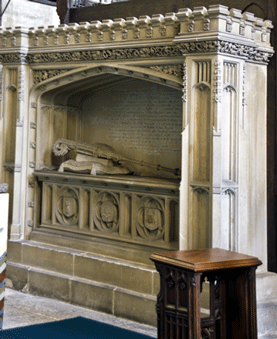 |
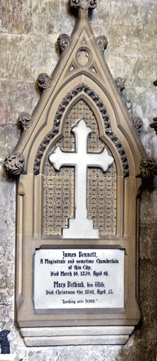 |
 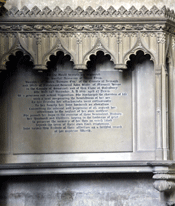 |
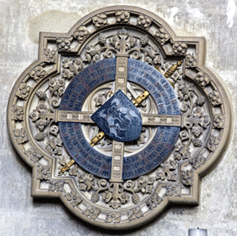 Above: Lt William Fisher (1845) of the Bengal Lancers. Quatrefoil by Osmond E Wall Left top: Elizabeth Douce (1810) White marble sarcophagus E Wall Left Bottom: Anna Elizabeth (Dawson) Slade (1819) Wall monument 15th century style by Osmond E Wall |
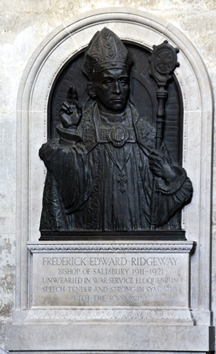 |
| Bishop John Fisher (1825) Canopied table tomb on which no effigy but cushion, crozier and Bible; by Osmond, 1828. Canopy later | James Bennett (1859) White cross in Gothick surround by Osmond E Wall | Bishop Frederick Edward Ridgeway (1921) Stone with relief half length portrait; bronze by A G Wyon E Wall | ||
| Chapel of St Margaret | Other Monuments in Saint Margaret's Chapel |
 |
William Douglas (1819) Marble tablet by
Osmond E
Wall John Douglas (1834) Marble tablet by Osmond E Wall |
| John Henry Jacob (1862) Coffin enclosed in a arcaded tomb chest with brass on top and inscription strip around base. Designed by G E Street |
| The Nave -
North
Aisle (progressing from east to west) |
| First Bay | ||||
 |
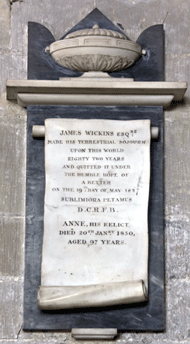 |
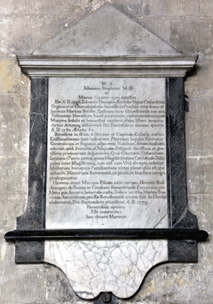 |
 |
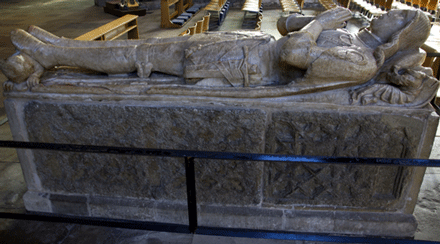 |
| Henry Hatcher (1846) Local historian. Stone tablet with Gothick architectural surround by Osmond | James Wickens (1827) & Ann (1850) White marble scroll surmounted with pediment and urn on black base | Dr John Stephens (1780) & Mary (1779) White marble tablet with pediment and black marble details | Sir John Cheyney (1509) Alabaster effigy, formerly on now destroyed canopied tomb chest (drawing extant); now on tomb chest made of fragments of other monuments. He was a supporter of Henry Tudor; fought at Bosworth and rescued Henry's standard when the bearer was killed. | |
| Second Bay | Third Bay | ||
 |
 |
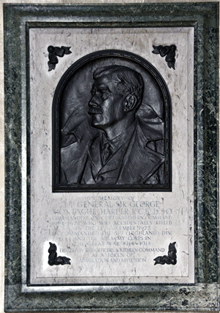 |
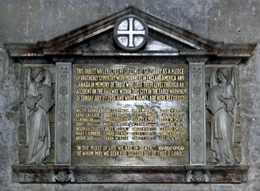 |
| Walter Lord Hungerford (1449) & his second wife Catherine Peverell. Table tomb constructed on the site of the chantry chapel in 1779 with fragments from that chapel and elsewhere; the top consists of two cut to size Purbeck floor slabs with brass indents | Horatio Third Earl Nelson (1913) White marble tablet in Purbeck frame |
Lt General Sir George Montague Harper (1922)
White marble tablet in gray marble frame
and bronze portrait in relief.
|
Coloured marble pedimented tablet with flanking angels in memory of those killed in a railway accident in Salisbury in 1906 |
| Fourth Bay | Fifth Bay | |||||
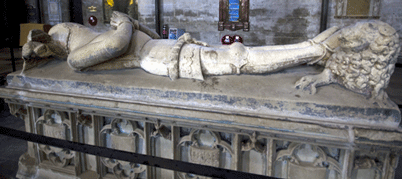
John Montacute, Earl of Salisbury
(1389) Sandstone tomb
chest with effigy in arnour. Remains of painting and
gilding. Tomb chest has shields bearing arms
|
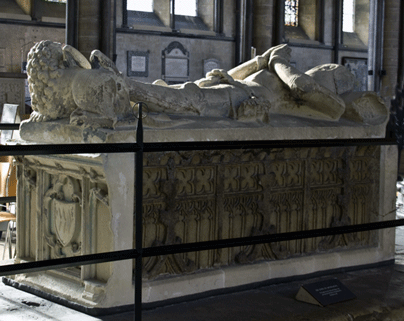 |
 |
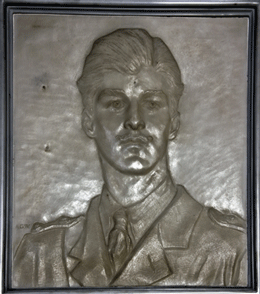 E W Tennant (1916) the soldier poet. White marble portrait relief signed AGW (Arthur George Walker RA). Kia on the Somme aged 19 |
|||
| Other Monuments in Fifth Bay |
| Purbeck marble tomb chest 15th century. Quatrefoil paneled sides, each with blank shield. Holes and an indent for lost brasses |
| Sixth Bay | Seventh Bay | Eighth Bay | ||||||
There are no monuments
listed in this bay
|
Purbeck marble table
tomb, late medieval, with flat sides with plain shields in
roundels formerly with brasses.
|
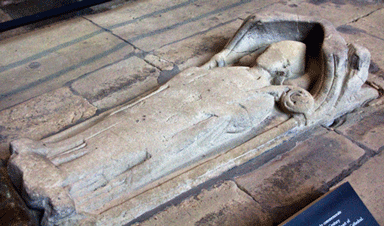 Above: The 'Boy Bishop' or, possibly, Bishop William de la Corner. Effigy only 1.1 m in length and of Bath Stone. 13th or early 14th century. |
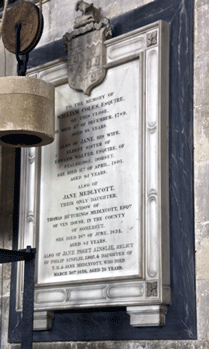 |
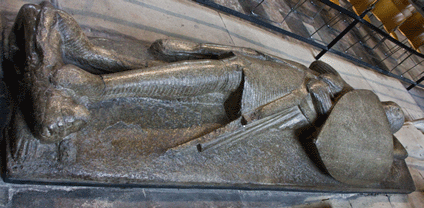 William Longespee (1250) Possibly, Son of Earl of Salisbury of the same name, whose effigy is in the south aisle. Purbeck marble effigy William Coles (1789), Jane Coles (1810), Jane Medlycott (1824) their daughter and her daughter, Jane Paget Ainslie (1839) White marble tablet, somewhat obscured by clock mechanism |
||||
| The Nave - South Aisle |
|
|||

Above: William Longespee, Earl of
Salisbury (1226) Illegitimate son of Henry II. Tournai
marble effigy with straight legs lying on a painted oak chest.
Arms carved in relief on shield.
Next right: Bishop Gilbert Burnet (1715) erected in 1960 by an American descendant Far right: Margaret Ashley (1679) Attributed to Jasper Latham |
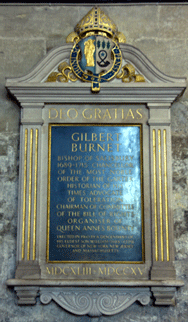 |
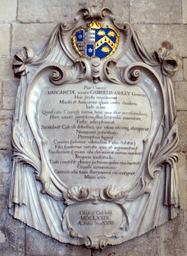 |
|
| Second Bay | ||
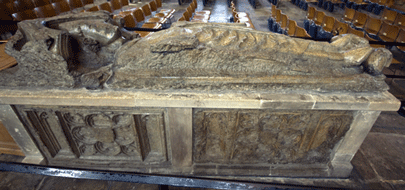  |
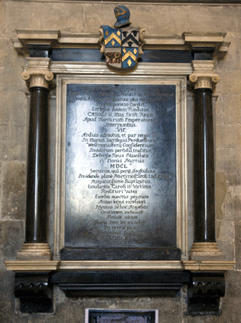
Left:
Bishop Walter de la Wyle
(1270) Purbeck marble
effigy on tomb chest of 1789 consists of slabs of Purbeck
marble from various tombs and canopies, including that of
Robert Lord Hungerford.
Above: Sir Henry Hyde (1650) marble, attributed to Joshua Marshall |
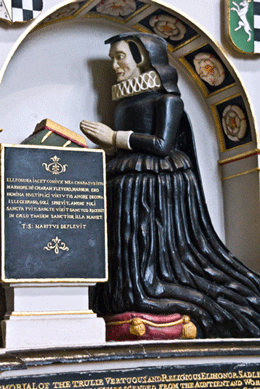 Elihonor Sadler (1622) Painted stone. The arms are Sadler impaling St Barbe and Powell also impaling St Barbe. In wall niche. |
| Third Bay | |||||
 |
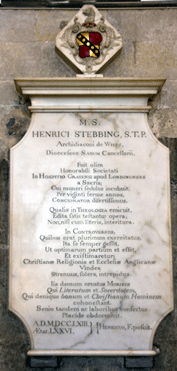 |
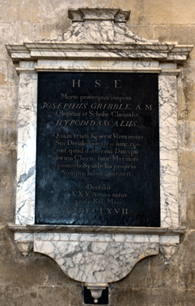 |
|
||
| Elizabeth Hyde (1667) daughter of Bishop Hyde. Marble, attrib. Thomas Burman | Joseph Gribble (1767) Black slate tablet with marble surround | Archdeacon Henry Stebbing (1763) Marble tablet | |||
| Fourth Bay | Fifth Bay | |||
 |
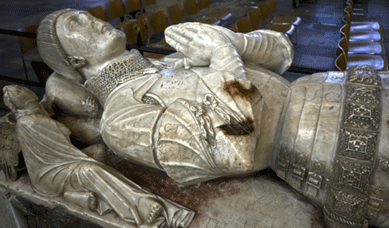 |
 |
 |
 |
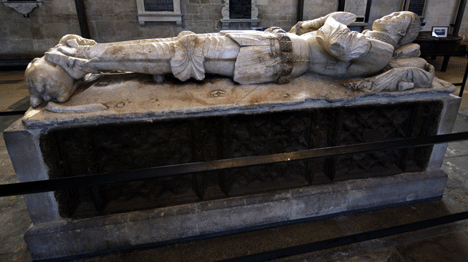 |
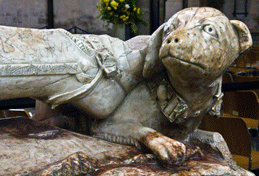
Above & Left:
Robert
Lord Hungerford (1459) Alabaster effigy in Milanese
armour; traces of pigment. The tomb chest is not original but
composed of 15th century reused Purbeck marble slabs, possibly
with paneling perhaps
from original tomb chest. Near Right Top: Mrs Mary (Mervin)
Cooke (1642) Slate tablet in stone Right Bottom:
Canon John Priaulx (1674)
Slate tablet in stone surround
|
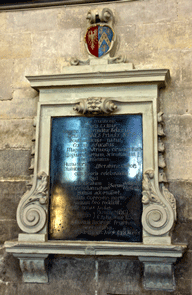 |

Above Top Left: Margaret
Tounson (1634) Slate tablet in painted stone frame with
broken pediment enclosing oval cartouche of arms
Above Top Right: Edward Davenant (1639) White tablet Above Bottom: Bishop Beauchamp (1481) Stone tomb chest with quatrefoil panels enclosing blank shields. |
|
| Sixth Bay | Seventh Bay | |||
 Above: Richard Brassey Hole MD (1849) Died of cholera aged 30. Modern stone tablet And below this: Bertram Charles Parsons (1968) Clerk of works for 22 years. Stone tablet |
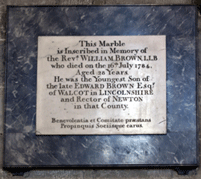 Above: Revd William Brown (1784) Right: Alexander Ballantyne MD White sarcophagus on gray marble slab erected 1783. Far Right; Henry Fawcett (1833) Sarah Maria Fawcett (1923) Marble |
 |
 |
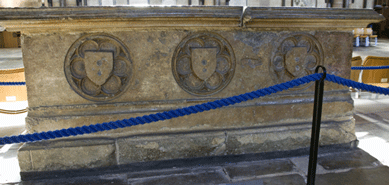 Above: William Geoffrey Canon and Chancellor |
| Other Monuments in Sixth Bay |
| Henry Hele MD White marble tablet |
| Eighth Bay | Ninth Bay | |||
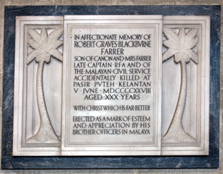 Robert Graves Blackburne Farrer (1928) Malay Civil Service. White marble tablet |
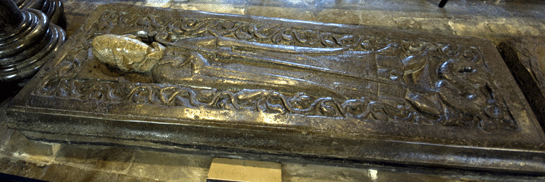  Above Top: Bishop Roger (1139) (?) Late 12th century coffin lid with effigy of a bishop Bottom Osmund (sometimes said to be Bishop Jocelin de Bohun, 1184) 12th century Purbeck marble coffin line with effigy of a bishop. Verses inscribed on chasuble and edge of lid. These two monuments were moved to the new cathedral from Old Sarum |
There are no monuments in this bay
|
||
|
||||
| Nave - West Wall |
 |
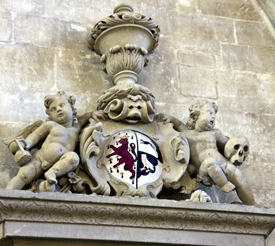
Above and Left: D'Aubigny
Turbeville (1696) & Ann (1694) Slate
or Purbeck tablet with stone base
Right & Far Right: Thomas, Baron Wyndham of Finglass (1745) gray and white marble of seated lady holding staff and harp. Signed Mich Rysbrack |
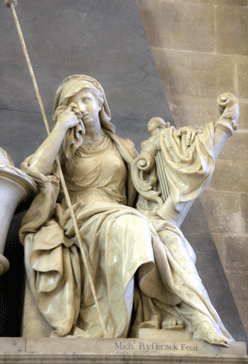 |
 |
| The Cloisters |
|
Vestibule (from the south transept to the east walk) |
Garth | South Walk | North Walk | |||
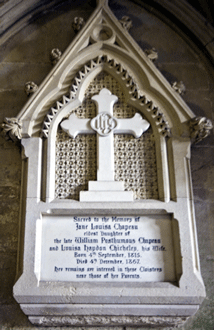 |
 |
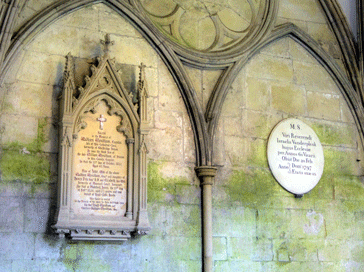 |
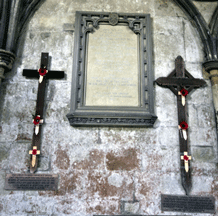 |
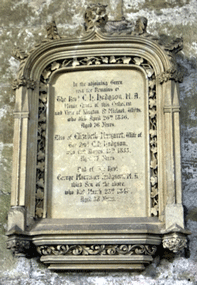 |
 |
|
|
Above:
Jane Louisa Chapeau (1867)
by
Osmond Also but not shown: William Osmond (1875) This is identical to the above. Right: Louisa Marie Dennison (1841) |
Wadham Wyndham (1845)
and
to the right of this Israel Vanderplank (1707) Also but not shown: John Edward Young (1832), William Arne(1824), John Etkins (1898), Arthur Thomas Corfe Anael (1866), Christopher Clarke (1835), Elizabeth Eyre (1850), Daniel Eyre, Henry Finley (1870) |
From
Left to Right Above: John Greenly (1832), Rev C H Hodgson (1856), William Osmond
mason.
Buried in Salisbury Cemetery.
|
||||
| East Walk | ||||
 |
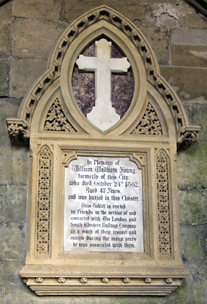 |
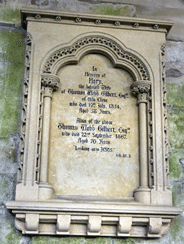 |
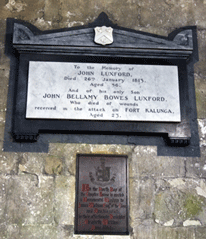 |
 |
| Left:
Top: William Posthumous
Chapeau (1833), his widow
Louisa Haydon
Chichele (1848)
and their son,
Francis William John Chicheley
(1831)
and their daughter
Louisa Elizabeth (1843) Bottom: Henry Stevens (1867) of the Middle Temple, his wife Frances Margaret (daughter of the above) & Henry Chichele Chapeau (1877) , brother of the latter. Above Far Left: William Wadham Young (1862) Above Centre Left: Mary Gilbert (1854) Above Centre Right: John Luxford (1813) The brass below records that the chapter house window dedicated to James Wicking 'of this close) and Ann. Dated 1861 Above Far Right: Caroline Luxford (1800) The brass below is in memory of James Hussey (1879) 'of this close'. Buried at Menton |
||||
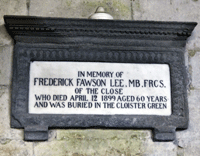
Above:
Frederick Fawson Lee MB FRCS (1899)
'of this close; buried in cloister green
Near Right: Henrietta Sophia Jacob Centre Right: George Lewis Benson (1862) Far Right: Harry Archer Mount (1790) and below this: William Young (1881) |
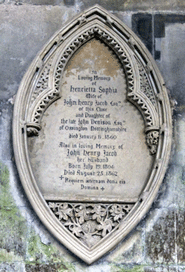 |
 |
 |
|
| The following I have not located |
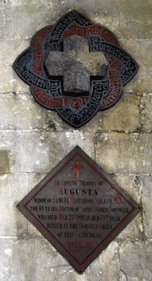 |
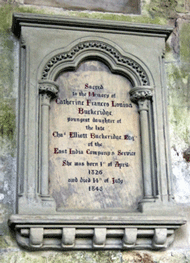 |
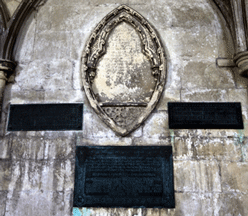 |
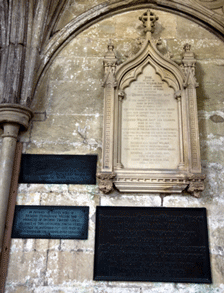 |
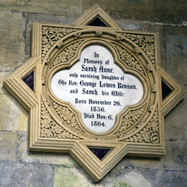 |
| James _lay (1837) and below this Augusta Walker (1900) buried in the cloister green | Catherine Frances Louisa Buckeridge (1845) | Ella Bingham | JanE Wilson | Sarah Anne Benson (1864) |
